

Rep. John Lewis remembers the fateful day in Selma. James Baldwin. Classic James Baldwin speech in Harlem / thepostarchive. Audio: James Baldwin and R.H. Darden in conversation. JAMES BALDWIN: Interview (Florida Forum, Miami)~~1963. James Baldwin Discusses Racism. Has the American Dream Been Achieved at the Expense of the American Negro. Baldwin Buckley Debate. The history of Tulsa's 'Black Wall Street' massacre. How Redlining Continues to Hold Back Black Americans. To understand racism in America, one must first disabuse themselves of the idea that race is a social construct—an idea that has been created and accepted by the people in a society.
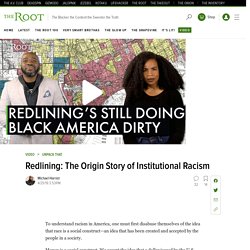
Money is a social construct. We accept the idea that a dollar issued by the U.S. government is worth more than Monopoly money. Even if our currency were backed by gold, the precious metal is only valuable because we have collectively agreed to its worth. Homeownership Is Rigged Against Black People. Instead, We Get "Da Hood"
The massacre of Tulsa's "Black Wall Street" When white supremacists overthrew a government. Ten Lessons for Talking About Race, Racism, and Racial Justice. Updated July 2020 As we strive to improve conversations about race, racism, and racial justice in this country, the environment in which we’re speaking seems to be constantly shifting, which shows that these conversations are more important than ever.
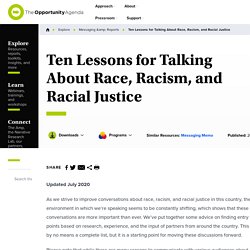
We’ve put together some advice on finding entry points based on research, experience, and the input of partners from around the country. This is by no means a complete list, but it is a starting point for moving these discussions forward. Please note that while there are many reasons to communicate with various audiences about racial justice issues, this memo focuses on messaging with the primary goal of persuading them toward action. There are many times when people need to communicate their anger, frustration, and pain to the world and to speak truth to power. 1.
Starting with values that matter to your audience can help people to “hear” your messages more effectively than dry facts or emotional rhetoric would. Sample Language: 2. Example: Brown eyes and blue eyes Racism experiment Children Session - Jane Elliott. FULL FEATURE. Malcolm X on Front Page Challenge, 1965: CBC Archives. Malcolm X: Best Interview EVER! Famous Malcolm X speech "Any means necessary"
James Baldwin "I Am Not Your Negro" #4: "If we were white, if we were Irish, if we were Jewish..." The 1619 Project. In August of 1619, a ship appeared on this horizon, near Point Comfort, a coastal port in the English colony of Virginia.

It carried more than 20 enslaved Africans, who were sold to the colonists. Brown eye blue eye, Jane Elliott. I Have a Dream Speech Study Guide. “I Have a Dream” is a sophisticated, hyper-referential speech that makes allusions to patriotic songs, political addresses, the speeches of other civil rights activists, the Bible, and even Shakespeare’s Richard III.

#MLK: The Three Evils of Society // #Nonviolence365. Selma Speeches Martin Luther King 1965. From civil rights to Smethwick: Why was Malcolm X in the West Midlands? Malcolm X's name resonates through history.
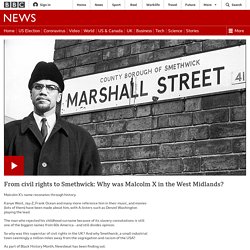
Kanye West, Jay-Z, Frank Ocean and many more reference him in their music, and movies (lots of them) have been made about him, with A-listers such as Denzel Washington playing the lead. How the Myth of a Liberal North Erases a Long History of White Violence. This article was originally published on the blog for the Smithsonian's National Museum of American History as the first of a five-part series titled "Black Life in Two Pandemics: Histories of Violence".
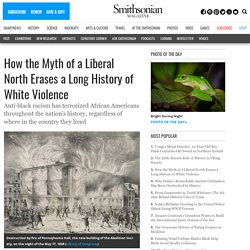
John Langston was running through a neighborhood in ruins. Burned homes and businesses were still smoking, their windows shattered. Langston was only 12 years old, but he was determined to save his brothers’ lives. He had spent the night in a safe house, sheltering from the white mobs that had attacked the city’s African American neighborhood. Sleep must have been difficult that night, especially after a cannon was repeatedly fired. Langston awoke to worse news. There is a toxic myth that encourages white people in the North to see themselves as free from racism and erases African Americans from the pre-Civil War North, where they are still being told that they don’t belong. Cincinnati was not alone. A Governor Bitterly Opposes Negro Education - Teaching American History. Governor James K.

Vardaman (MS) The legendary debate that laid down US political lines on race, justice and history. Aeon email newsletters are issued by the not-for-profit, registered charity Aeon Media Group Ltd (Australian Business Number 80 612 076 614).
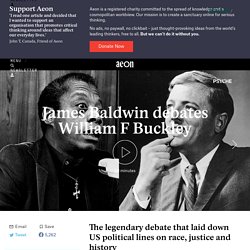
This Email Newsletter Privacy Statement pertains to the personally identifying information you voluntarily submit in the form of your email address to receive our email newsletters More generally, when visiting the Aeon site you should refer to our site Privacy Policy here. This Email Newsletter Privacy Statement may change from time to time and was last revised 18 May, 2020. By clicking ‘subscribe’ you agree to the following: We will use the email address you provide to send you daily and/or weekly emails (depending on your selection). Unsubscribing. Has the American Dream Been Achieved at the Expense of the American Negro. Malcolm X: Best Interview EVER! Why America Hates Malcolm X And The Black Panther Party BUT Loves Colombus And Confederate Heritage. Famous Malcolm X speech "Any means necessary"
Race/Related. While I Yet Live. 18 Key Figures From The Civil Rights Movement. A Better Way to Teach the Civil Rights Movement. A native of the Magnolia State, Jessica Dickens grew up just a short drive away from one of the most infamous events of Mississippi Freedom Summer: the 1964 disappearance and murder of three civil rights workers on their way to investigate a church burning.
She’s also a graduate of one of Mississippi’s segregated high schools—part of a group of all-white private schools established in the 1950s to thwart school integration. Yet even with her personal ties to civil rights history, the central figures in Dickens’s history lessons in her early teaching years in Mississippi were Martin Luther King Jr. and Rosa Parks—two of the most memorable leaders from her own schooling, and staples of U.S. history textbooks. It was only with exposure to fresh thinking through a teaching fellowship on civil rights history—and after uncovering her state’s untold stories—that the 11-year veteran began to shift her teaching approach. It’s a common oversight in America’s classrooms. Debunking Common Myths. David Olusoga: ‘Black soldiers were expendable – then forgettable’ Power to the People - the Black Panthers by photographer Stephen Shames. “I don’t know how it happened but at one point I started.
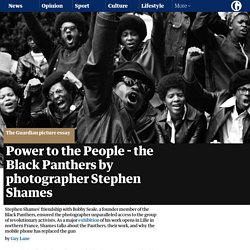
I must have gone by the Panther office, neither Bobby Seale nor I can remember, but I went by and they liked my pictures and they wanted to use them in their paper so I started taking pictures for them. But really I hadn’t been a photographer for even a whole year. I wasn’t a professional and I didn’t quite know what I was doing.” A girl holds a ‘Free the Chicago 8’ placard at a rally for Panther George Jackson and the Soledad Brothers in DeFremery Park, West Oakland, 1969.
Runaway Slaves in Britain. Martin Luther King Jr.'s speech analyzed by Nancy Duarte. Mission US. Civil Rights Legend Rosa Parks on the Meaning of Life. “The whole future lies in uncertainty: live immediately,” Seneca counseled two millennia ago as he contemplated the shortness of life and urged us to live wide rather than long.
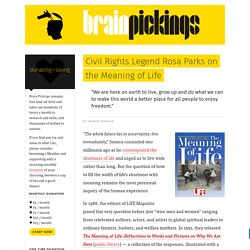
But the question of how to fill the width of life’s shortness with meaning remains the most perennial inquiry of the human experience. In 1988, the editors of LIFE Magazine posed this very question before 300 “wise men and women” ranging from celebrated authors, actors, and artists to global spiritual leaders to ordinary farmers, barbers, and welfare mothers. MLK I Have A Dream Speech. Missed in History: Brown v. Board Part 2. The battle to desegregate schools after the Supreme Court's decision in Brown v. Board of Education gets a lot of attention in classes on American history and the American Civil Rights Movement. But the struggle to integrate schools went on well past the end of what we think of as the Civil Rights Movement. In the 1970s, additional court decisions brought busing to the forefront of the fight for integration - which meant that protests very similar to what the South had seen in the '50s and '60s struck cities and towns in the nation's North and West.
In many places, de facto segregation continues today. The NAACP: A Century in the Fight for Freedom - Primary Source Set. Skip navigation Library of Congress Teachers Suggestions enabled. Jim Crow in America - Primary Source Set. Skip navigation Library of Congress Teachers Suggestions enabled. The Library of Congress > Teachers > Classroom Materials > Primary Source Sets > Jim Crow and Segregation Print Subscribe Share/Save Give Feedback Jim Crow and Segregation Teacher’s Guide. Jim Crow Segregation: The Difficult and Anti-Democratic Work of White Supremacy. Abstract Segregation contradicts what most students have learned about American freedom and democracy. Say it Plain, Say it Loud. Spanning the 20th century, this collection is a vivid account of how African Americans sounded the charge against racial injustice, exhorting the country to live up to its democratic principles. Television News of the Civil Rights Era. Us civil rights movement.
Civil Rights Movement - Black History. Missed in History: Brown v. Board Part 2. Stuff You Missed in History. The Freedom Riders: CORE's First Wave. How the Civil Rights Movement Worked. National Archives Experience.
Stuff You Missed in History. Martin Luther King Jr. - Biography. Martin Luther King, Jr., (January 15, 1929-April 4, 1968) was born Michael Luther King, Jr., but later had his name changed to Martin. Civil Rights Movement 1955-1965: Freedom Rides. [Previous Topic] [Next Topic] [Up] [Table of Contents] [Citation Guide] [Feedback] [Search] [Home] [Help!]
"At our first stop in Virginia . . . The Supreme Court . Expanding Civil Rights . Landmark Cases . Brown v. Board of Education (1954) A Brief History of Jim Crow. The Rise and Fall of Jim Crow. Resources. The Rise and Fall of Jim Crow. Civil Rights Movement 1955-1965: The Montgomery Bus Boycott. Early Civil Rights Struggles: The Murder of Emmett Till. Civil Rights Chronology. American History Resource Center.